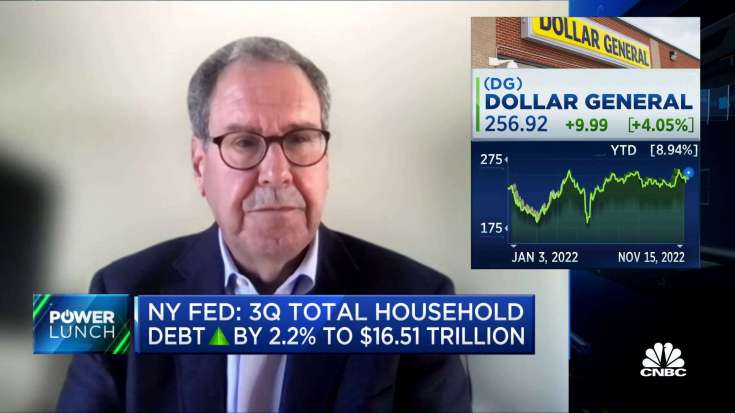Luis Alvarez | Digitalvision | Getty Images
Households increased debt during the third quarter at the fastest pace in 15 years due to hefty increases in credit card usage and mortgage balances, the Federal Reserve reported Tuesday.
Total debt jumped by $351 billion for the July-to-September period, the largest nominal quarterly increase since 2007, bringing the collective household IOU in the U.S. to a fresh record $16.5 trillion. That’s an increase of 2.2% from the previous quarter and 8.3% from a year ago.
The increase follows a $310 billion jump in the second quarter and represents a $1.27 trillion annual increase.
Debt has surged over the past year due to inflation running near its highest pace in more than 40 years and amid rising interest rates and strong consumer demand.

The biggest contributors to that debt load came from mortgage balances, which rose $1 trillion from a year ago to $11.7 trillion, and credit card debt, which climbed to $930 billion.
The credit card balance collectively rose more than 15% from the same period in 2021, the largest annual jump in more than 20 years, according to the New York Fed, which released the report. The increase “towers over the last eighteen years of data,” a group of Fed researchers said in a blog post on the central bank site.
“Credit card, mortgage, and auto loan balances continued to increase in the third quarter of 2022 reflecting a combination of robust consumer demand and higher prices,” said Donghoon Lee, economic research advisor at the New York Fed. “However, new mortgage originations have slowed to pre-pandemic levels amid rising interest rates.”
New York Fed researchers attributed the credit card growth to “very robust” consumption, rising prices and consumers using substantial levels of savings that remain on accounts.
Along with the rise in balances has come an increase in delinquencies.
However, while “delinquency rates are rising, they remain low by historical standards and suggest consumers are managing their finances through the period of increasing prices,” the researchers wrote.
Elsewhere in the report, the Fed said auto loan balances edged higher to $1.52 trillion while student loan debt nudged lower to $1.57 trillion. Student loan debt is the lowest since the second quarter of 2021 amid an extended period of forbearance and the Biden administration’s efforts to forgive some education loan debt.
Auto loan debt, while posting only a slight increase on a quarterly basis, is up 5.6% from a year ago.
Mortgage balances continued to grind higher amid a sharp increase in interest rates that has seen 30-year mortgages loan rates hover around 7%. Total debt climbed even though originations fell sharply, dropping nearly 17% to $633 billion.
Foreclosures remained low even as a pandemic-related moratorium expired. Student loan delinquent rates remained around 4%.


